Elevated Temperature Tensile Creep Behavior of Aluminum Borate Whisker-Reinforced Aluminum Alloy Composites (ABOw/Al–12Si)
Abstract
:1. Introduction
2. Material and Experimental Procedures
3. Results and Discussion
3.1. Mechanical Properties
3.2. Tensile Creep Properties
3.3. Creep Activation Energy and Stress Exponent
3.4. Threshold Stress Analysis
3.5. Contribution of Whiskers by Load Transfer
3.6. Creep Fracture Behavior
4. Conclusions
- (1)
- The analysis of the ABOw/Al–12Si composite creep data showed that this creep mechanism was dislocation climb (n = 4.03–6.02) with a creep activation energy of 148.75 kJ/mol. The dislocation climb in this composite was the dominant creep mechanism.
- (2)
- Static creep measurements results indicated that this composite has a very long stationary creep stage, compared to the unreinforced aluminum matrixes. Furthermore, the creep rate of the ABOw/Al–12Si composite was increased by about three orders of magnitude compared to that of the Al–12Si alloy under same testing condition. This indicated that the creep resistance of the composite has been greatly improved by adding whiskers.
- (3)
- The threshold stresses of the ABOw/Al–12Si composite were determined by the extrapolation technique, exhibiting a strong temperature dependence. For the static creep, a stress exponent of 4 was calculated by the means of introducing threshold stress into the analysis, and the threshold stresses decreased by improving the creep temperature from 300 to 400 °C.
- (4)
- A load transfer model was introduced to interpret the contribution of whiskers to the creep resistance of the composite. The experimental results values are well consistent with the results obtained from the creep rates based on the load transfer model.
- (5)
- The creep fracture surface of the ABOw/Al–12Si composite indicated that the main fracture mechanism is reinforcing whiskers rather than debonding whiskers at 300 °C whereas the dominant fracture mechanism at 400 °C is the interfacial debonding between the whiskers and the matrix. Meanwhile, the fracture surfaces consisted of interfacial debonding and fracture whiskers at 350 °C.
Author Contributions
Funding
Institutional Review Board Statement
Informed Consent Statement
Data Availability Statement
Conflicts of Interest
References
- Tian, Y.-J.; Zuo, H.-W.; Dong, Y.-M.; Wei, D.-S. Adaptive threshold speech de-noising based on Bark scale wavelet package. J. Comput. Appl. 2010, 30, 3111–3114. [Google Scholar] [CrossRef]
- Srivyas, P.D.; Charoo, M. Application of Hybrid Aluminum Matrix Composite in Automotive Industry. Mater. Today Proc. 2019, 18, 3189–3200. [Google Scholar] [CrossRef]
- Qin, Z.; Jia, C.; Zhang, W.; Wang, L.; Zhaoju, Q.; Chuanfa, J.; Weizheng, Z.; Lijun, W. Investigations on ablation for highly-intensified diesel engine piston material. Case Stud. Therm. Eng. 2019, 13, 100371. [Google Scholar] [CrossRef]
- Tu, J.; Yang, Y. Tribological behaviour of Al18B4O33-whisker-reinforced hypoeutectic Al–Si–Mg-matrix composites under dry sliding conditions. Compos. Sci. Technol. 2000, 60, 1801–1809. [Google Scholar] [CrossRef]
- Suganuma, K.; Fujita, T.; Suzuki, N.; Niihara, K. Aluminium composites reinforced with a new aluminium borate whisker. J. Mater. Sci. Lett. 1990, 9, 633–635. [Google Scholar] [CrossRef]
- Zasadzińska, M.; Strzępek, P.; Mamala, A.; Noga, P. Reinforcement of Aluminium-Matrix Composites with Glass Fibre by Metallurgical Synthesis. Materials 2020, 13, 5441. [Google Scholar] [CrossRef]
- Samal, P.; Vundavilli, P.R.; Meher, A.; Mahapatra, M.M. Recent progress in aluminum metal matrix composites: A review on processing, mechanical and wear properties. J. Manuf. Process. 2020, 59, 131–152. [Google Scholar] [CrossRef]
- Uyumaz, A. Combustion, performance and emission characteristics of a DI diesel engine fueled with mustard oil biodiesel fuel blends at different engine loads. Fuel 2018, 212, 256–267. [Google Scholar] [CrossRef]
- Thiel, N.; Weimar, H.-J.; Kamp, H.; Windisch, H. Advanced Piston Cooling Efficiency: A Comparison of Different New Gallery Cooling Concepts. SAE Tech. Paper Ser. 2007. [Google Scholar] [CrossRef]
- Peng, L.M.; Zhu, S.J.; Wang, F.G.; Chen, H.R.; Ma, Z.Y.; Bi, J. Creep behavior in an Al-Fe-V-Si alloy and SiC whisker-reinforced Al-Fe-V-Si composite. J. Mater. Sci. 1998, 33, 5643–5652. [Google Scholar] [CrossRef]
- Ma, Z.; Tjong, S. Creep deformation characteristics of discontinuously reinforced aluminium-matrix composites. Compos. Sci. Technol. 2001, 61, 771–786. [Google Scholar] [CrossRef]
- A Hamed, O.; Shady, M.; El-Desouky, A. Creep behavior of a cast 359/SiC/10p aluminum composite. Mater. Des. 2001, 22, 473–479. [Google Scholar] [CrossRef]
- Ji, F.; Ma, M.; Song, A.; Zhang, W.; Zong, H.; Liang, S.; Osamu, Y.; Liu, R. Creep behavior of in situ TiCP/2618 aluminum matrix composite. Mater. Sci. Eng. A 2009, 506, 58–62. [Google Scholar] [CrossRef]
- Zhu, S.; Peng, L.; Ma, Z.; Bi, J.; Wang, F.; Wang, Z. High temperature creep behavior of SiC whisker-reinforced AlFeVSi composite. Mater. Sci. Eng. A 1996, 215, 120–124. [Google Scholar] [CrossRef]
- Xu, S.; Wang, L.; Li, H.; Qu, C.; Fei, W. Effects of rolling temperature on hot rolling behaviors and mechanical properties of ABOw/6061Al composites. Mater. Sci. Eng. A 2014, 615, 208–213. [Google Scholar] [CrossRef]
- Fei, W.D.; Jiang, X.D.; Li, C.; Yao, C.K. Effect of interfacial reaction on the Young’s modulus of aluminium borate whisker reinforced aluminium composite. J. Mater. Sci. Lett. 1996, 15, 1966–1968. [Google Scholar] [CrossRef]
- Ahn, C.; Jo, I.; Ji, C.; Cho, S.; Mishra, B.; Lee, E. Creep behavior of high-pressure die-cast AlSi10MnMg aluminum alloy. Mater. Charact. 2020, 167, 110495. [Google Scholar] [CrossRef]
- Li, Y.; Langdon, T.G. A comparison of the creep properties of an Al-6092 composite and the unreinforced matrix alloy. Met. Mater. Trans. A 1998, 29, 2523–2531. [Google Scholar] [CrossRef]
- Zheng, M.; Wu, K.; Liang, H.; Kamado, S.; Kojima, Y. Microstructure and mechanical properties of aluminum borate whisker-reinforced magnesium matrix composites. Mater. Lett. 2002, 57, 558–564. [Google Scholar] [CrossRef]
- Huang, M.H.; Wang, H.W. Creep Behavior of Short Alumina Fiber Reinforced Al Based Composite. Acta Mater. Comp. Sini. 2004, 5, 7–10. [Google Scholar] [CrossRef]
- Kumar, H.; Chaudhari, G. Creep behavior of AS41 alloy matrix nano-composites. Mater. Sci. Eng. A 2014, 607, 435–444. [Google Scholar] [CrossRef]
- Mordike, B. Creep-resistant magnesium alloys. Mater. Sci. Eng. A 2002, 324, 103–112. [Google Scholar] [CrossRef]
- Yin, X.N.; Zhen, L.H.; Zhao, J. Establishment of steady creep constitutive equation of 2219 aluminum alloy. Chin. J. Nonferrous Met. 2014, 24, 2250–2256. [Google Scholar] [CrossRef]
- Jiang, B.; Zhang, D.; Sun, C.; Li, N.; Liu, Y.; Cao, Z. Microstructure evolution and creep behavior of high-pressure die-cast Mg–9Al–1Zn–1Sr alloy. Mater. Sci. Eng. A 2019, 766, 138388. [Google Scholar] [CrossRef]
- Peng, L.; Zhu, S.; Ma, Z.; Bi, J.; Wang, F.; Chen, H.; Northwood, D. High temperature creep deformation of Al18B4O33 whisker-reinforced 8009 Al composite. Mater. Sci. Eng. A 1999, 265, 63–70. [Google Scholar] [CrossRef]
- Akbari, M.K.; Baharvandi, H.; Shirvanimoghaddam, K. Tensile and fracture behavior of nano/micro TiB2 particle reinforced casting A356 aluminum alloy composites. Mater. Des. 2015, 66, 150–161. [Google Scholar] [CrossRef]
- Gong, D.; Cao, Y.; Zhan, Y.; Liu, X.; Guan, J.; Jiang, L.; Kang, P.; Yu, Z.; Hussain, M.; Wu, G. Micro-creep behavior and microstructure evolution of SiCp/2024Al composite. Mater. Sci. Eng. A 2020, 771, 138606. [Google Scholar] [CrossRef]
- Abdu, M.T.; Soliman, M.S.; El-Danaf, E.A.; Almajid, A.A.; Mohamed, F.A. Creep characteristics and microstructure in nano-particle strengthened AA6082. Mater. Sci. Eng. A 2012, 531, 35–44. [Google Scholar] [CrossRef]
- González-Doncel, G.; Sherby, O. High temperature creep behavior of metal matrix Aluminum SiC composites. Acta Met. et Mater. 1993, 41, 2797–2805. [Google Scholar] [CrossRef]
- Xun, Y.; Mohamed, F.A. Slip-accommodated superplastic flow in Zn-22 wt% Al. Philos. Mag. 2003, 83, 2247–2266. [Google Scholar] [CrossRef]
- Park, K.-T.; Mohamed, F.A. Creep strengthening in a discontinuous SiC-Al composite. Met. Mater. Trans. A 1995, 26, 3119–3129. [Google Scholar] [CrossRef]
- Mohammadizadeh, M.; Fidan, I.; Allen, M.; Imeri, A. Creep behavior analysis of additively manufactured fiber-reinforced components. Int. J. Adv. Manuf. Technol. 2018, 99, 1225–1234. [Google Scholar] [CrossRef]
- Zhou, P.; Zhang, S.; Li, M.; Wang, H.; Cheng, W.; Wang, L.; Li, H.; Liang, W.; Liu, Y. The creep behavior of Mg–9Al–1Si–1SiC composite at elevated temperature. J. Magnes. Alloy. 2020, 8, 944–951. [Google Scholar] [CrossRef]
- Zhu, S.; Mukherji, D.; Chen, W.; Lu, Y.; Wang, Z.; Wahi, R. Steady state creep behaviour of TiC particulate reinforced Ti–6Al–4V composite. Mater. Sci. Eng. A 1998, 256, 301–307. [Google Scholar] [CrossRef]
- Zhang, G.-H.; Zhang, J.-X.; Li, B.-C.; Cai, W. Characterization of tensile fracture in heavily alloyed Al-Si piston alloy. Prog. Nat. Sci. 2011, 21, 380–385. [Google Scholar] [CrossRef] [Green Version]
- Zhang, X.; Zhang, W.; Yuan, Y.; Feng, Z.; Wang, Y. Elevated temperature mechanical properties and fracture behaviors of the bond zone of aluminum matrix composites (Al–12Si/ABOw) with Al–12Si alloys. Mater. Sci. Eng. A 2017, 700, 25–32. [Google Scholar] [CrossRef]
- Yue, H.; Wang, L.; Fei, W. Improvement of the tensile strength of Al18B4O33w/Al composite at elevated temperatures by change of interfacial state. Mater. Sci. Eng. A 2008, 486, 409–412. [Google Scholar] [CrossRef]
- Wang, L.; Hu, J.; Li, Z.; Fei, W. Fracture behavior of aluminum borate whisker-reinforced aluminum alloy 6061 composite. Mater. Sci. Eng. A 2008, 497, 358–362. [Google Scholar] [CrossRef]

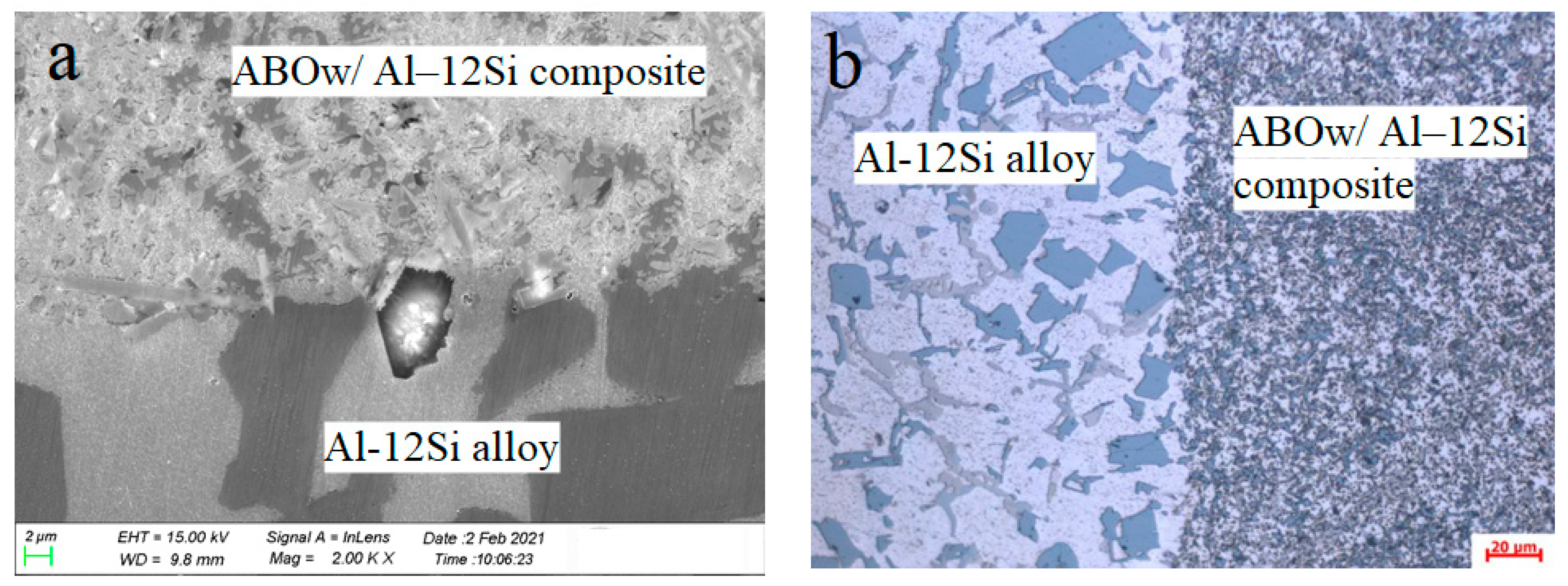

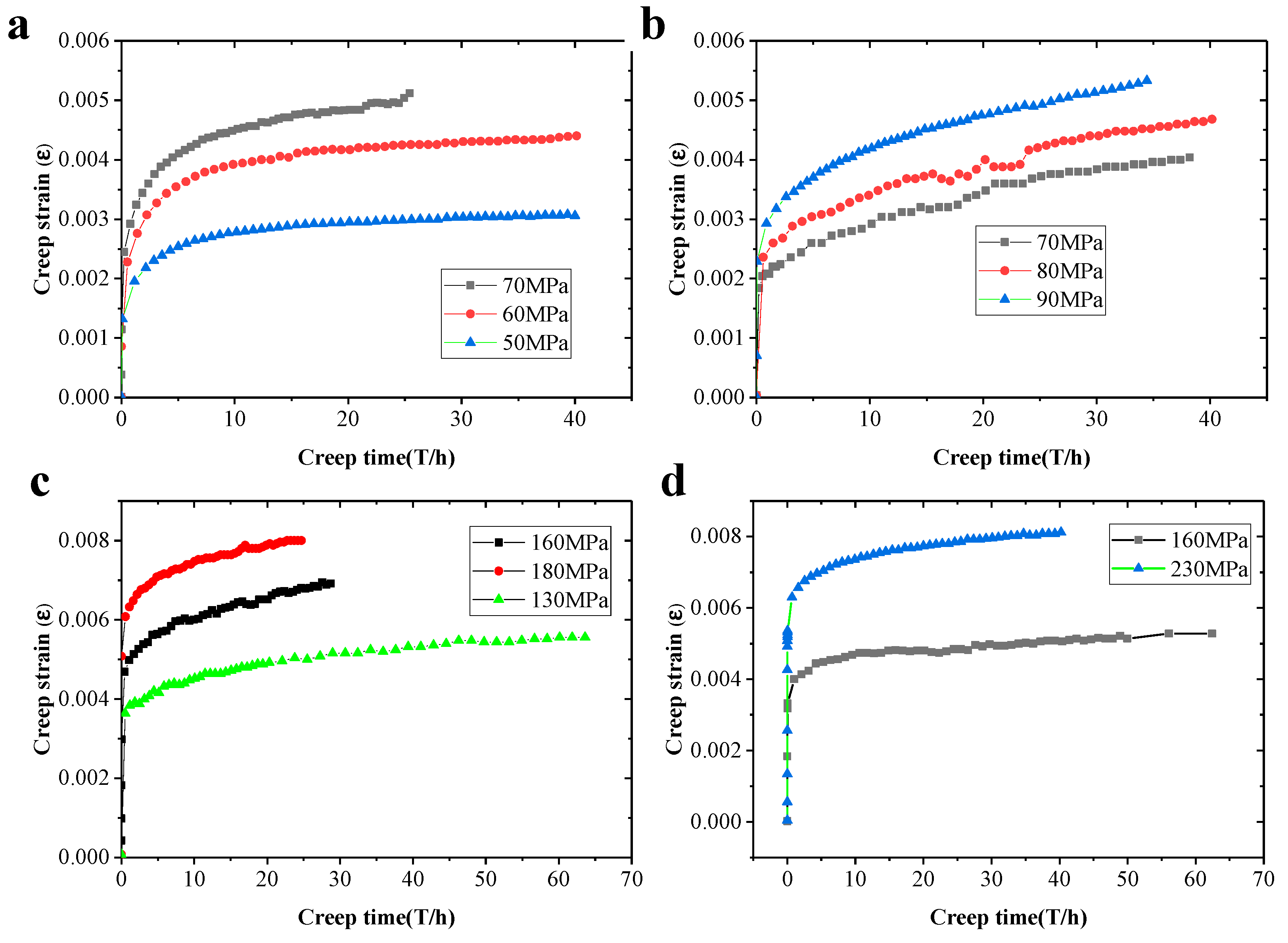
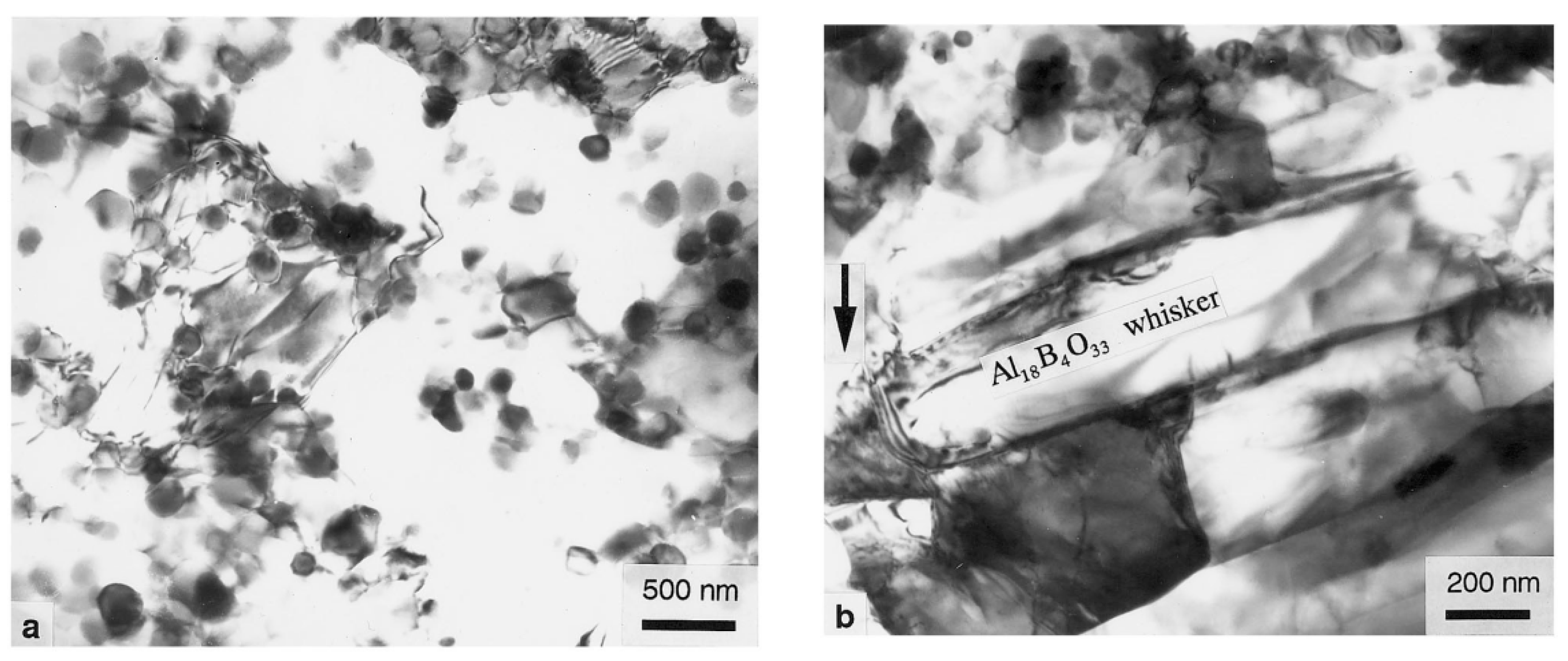


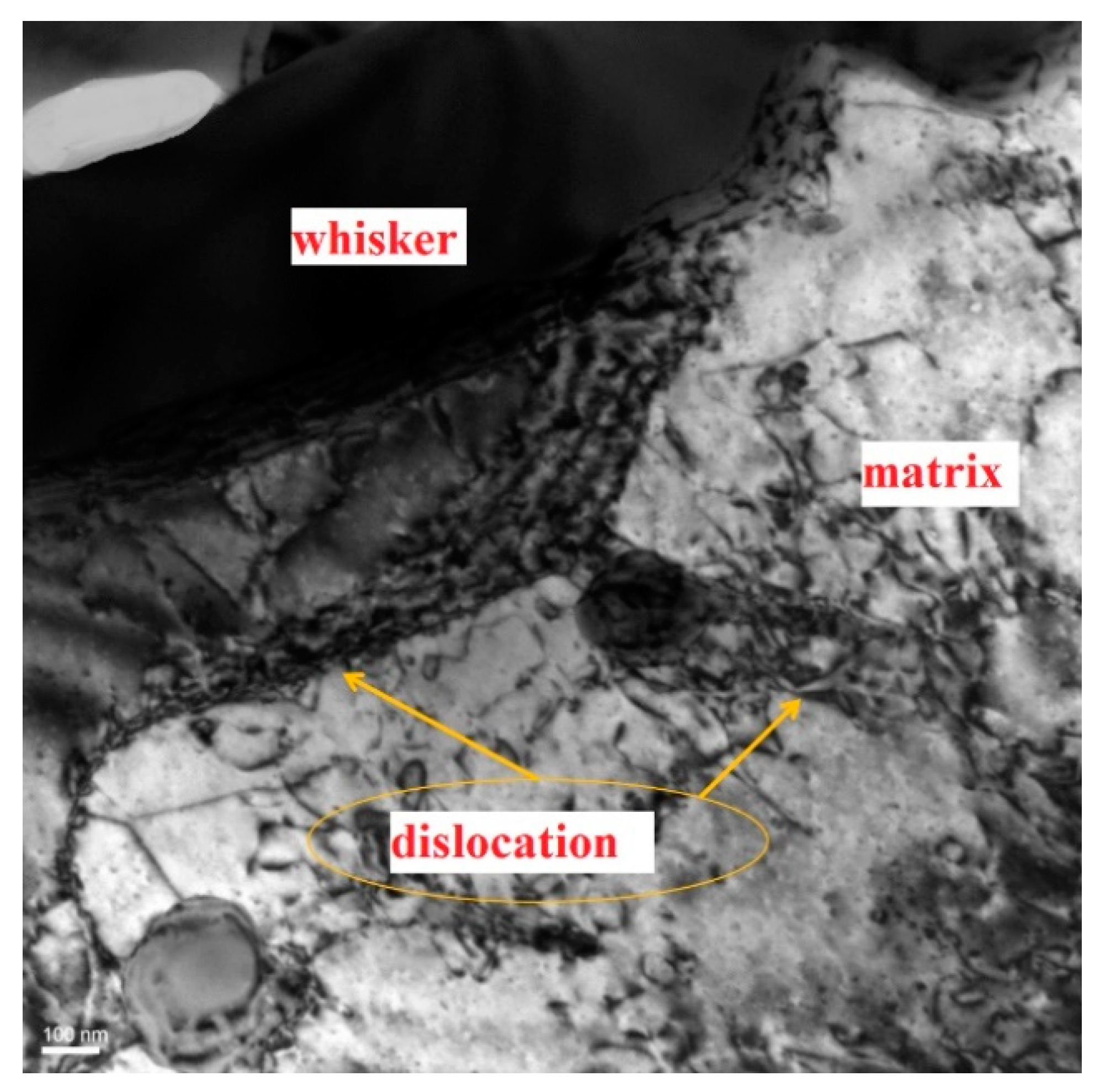
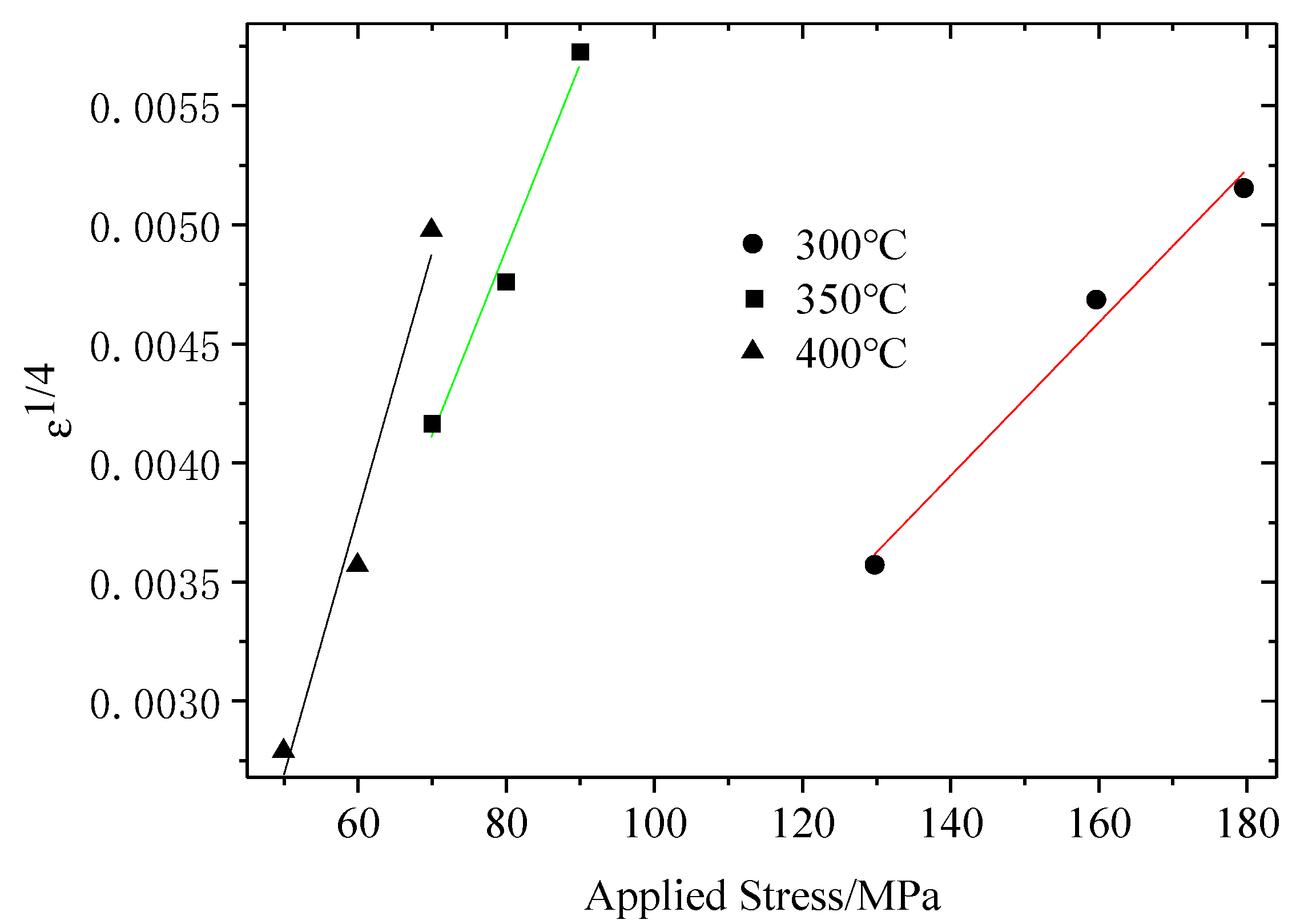


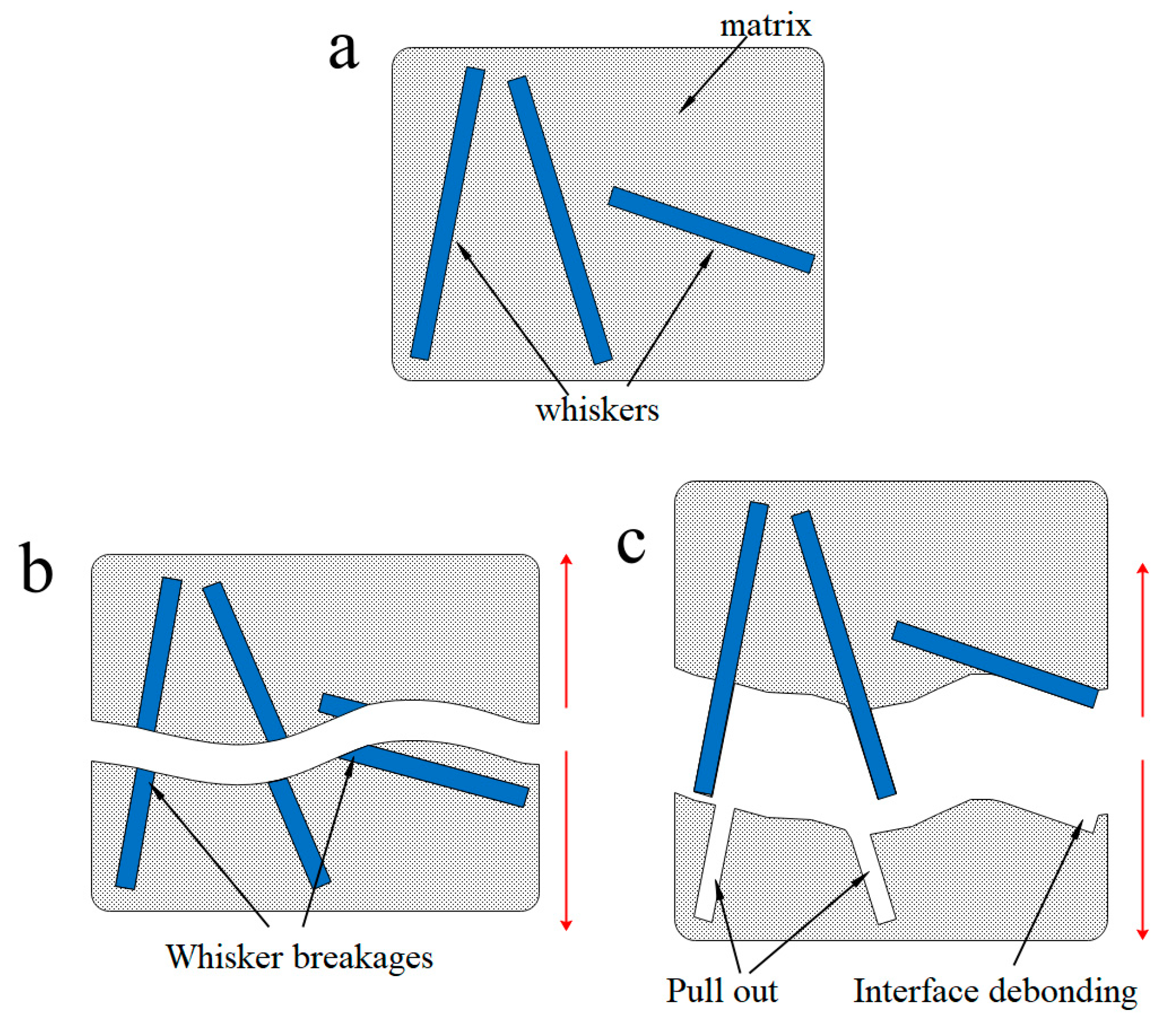
| Si | Cu | Ni | Mg | Fe | Mn | Ti | Zn | Al |
|---|---|---|---|---|---|---|---|---|
| 12.47 | 4.21 | 2.97 | 0.80 | 0.38 | 0.25 | 0.112 | 0.007 | Bal |
| Materials | Temperature (°C) | E (GPa) | UTS (MPa) | Elongation (%) |
|---|---|---|---|---|
| Al–12Si | 25 | 80.3 | 312 | 3.3 |
| 200 | 76.8 | 232 | 4.0 | |
| 250 | 67.6 | 166 | 4.8 | |
| 300 | 55.8 | 130 | 5.3 | |
| 350 | 54.6 | 94 | 6.0 | |
| ABOw/Al–12Si | 25 | 113 | 394 | 0.61 |
| 200 | 98 | 356 | 0.86 | |
| 250 | 87 | 327 | 1.01 | |
| 300 | 81 | 253 | 1.14 | |
| 350 | 75 | 217 | 1.25 |
| Temperature (°C) | Stress (MPa) | Steady-State Creep Rate (×10−8 s−1) |
|---|---|---|
| 250 | 160 | 0.27639 |
| 230 | 0.40833 | |
| 300 | 130 | 0.27056 |
| 160 | 0.94889 | |
| 180 | 0.98222 | |
| 350 | 70 | 0.62917 |
| 80 | 0.74417 | |
| 90 | 1.10056 | |
| 400 | 50 | 0.11306 |
| 60 | 0.26972 | |
| 70 | 0.86861 |
| Materials | Temperature (°C) | Stress Exponent |
|---|---|---|
| ABOw/Al–12Si | 300 | 4.03 |
| 350 | 4.41 | |
| 400 | 6.02 | |
| Al–12Si | 350 | 4.18 |
| Temperature (°C) | Threshold Stress (MPa) |
|---|---|
| 300 | 37.41 |
| 350 | 25.85 |
| 400 | 17.36 |
Publisher’s Note: MDPI stays neutral with regard to jurisdictional claims in published maps and institutional affiliations. |
© 2021 by the authors. Licensee MDPI, Basel, Switzerland. This article is an open access article distributed under the terms and conditions of the Creative Commons Attribution (CC BY) license (http://creativecommons.org/licenses/by/4.0/).
Share and Cite
Ji, Y.; Yuan, Y.; Zhang, W.; Xu, Y.; Liu, Y. Elevated Temperature Tensile Creep Behavior of Aluminum Borate Whisker-Reinforced Aluminum Alloy Composites (ABOw/Al–12Si). Materials 2021, 14, 1217. https://doi.org/10.3390/ma14051217
Ji Y, Yuan Y, Zhang W, Xu Y, Liu Y. Elevated Temperature Tensile Creep Behavior of Aluminum Borate Whisker-Reinforced Aluminum Alloy Composites (ABOw/Al–12Si). Materials. 2021; 14(5):1217. https://doi.org/10.3390/ma14051217
Chicago/Turabian StyleJi, Yameng, Yanpeng Yuan, Weizheng Zhang, Yunqing Xu, and Yuwei Liu. 2021. "Elevated Temperature Tensile Creep Behavior of Aluminum Borate Whisker-Reinforced Aluminum Alloy Composites (ABOw/Al–12Si)" Materials 14, no. 5: 1217. https://doi.org/10.3390/ma14051217






